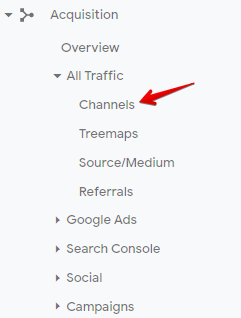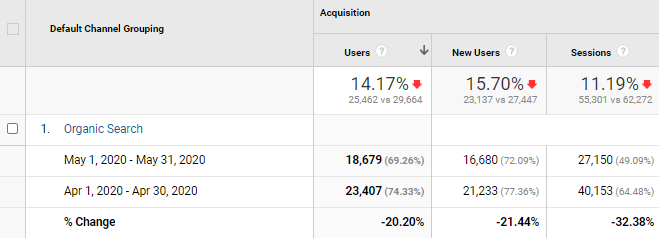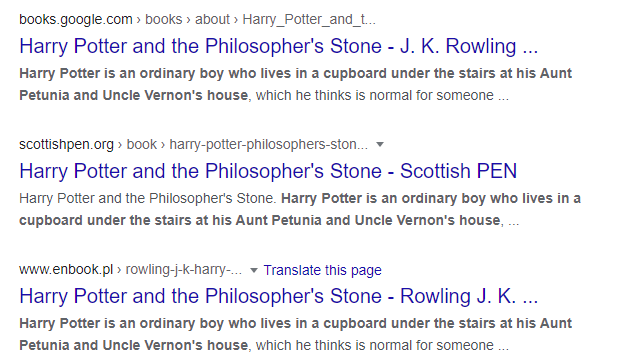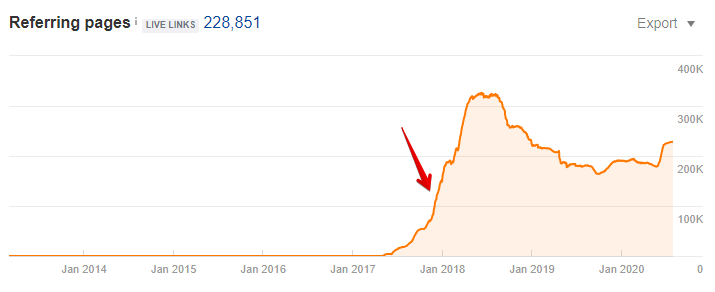9 Reasons Why Your Website Deserves a Google Penalty (And How to Fix It)

Google is trying to provide its users with the best search results possible. This search engine regularly updates its algorithms to ensure that the search results respond best to users’ needs, which is why Google rewards trustworthy and reliable sites with high-quality content and penalizes sites that do not bring any value to users. In this article, you will explore the main 9 reasons why your website may have been hit by a Google penalty. What’s more, I will also give you some tips on how to fix them!
What Is Google Penalty? Definition
Google penalty is a situation in which a website no longer appears in the search results or its ranking positions have dropped drastically. When a website gets a Google penalty, then it becomes practically invisible in the search results. This causes a dramatic decrease in website traffic.
Sudden drops in the search results are caused by frequent changes in search engine algorithms, which are aimed at enhancing the quality of search results tailored to users’ needs.
How to Recognize That a Website Is Penalized by Google?
There are several ways to check if your website is penalized by Google:
1. In SERP checker
Do you have an account in a SERP checker that regularly (e.g. every day or every week) monitors ranking positions of the most important keywords for your business in Google search results? You can quickly track down any alarming drops for numerous phrases. This is the main source of information about the visibility in the search results.
2. Manually
If you do not have a SERP checker account, you can control the visibility of your site on your own. This is, in fact, a much more time-consuming activity. All you need to do is to enter in the “Search” bar the most important for you keywords that have the greatest potential to increase traffic to your site to see which position your website holds today.
3. In Google Search Console
A great way to identify Google penalties is Google Search Console. Log in to your account, select Search Traffic and then choose Manual Actions. If the message “No issues detected” appears, it means that you are safe and that your website has no penalties from the search engine.
4. In Google Analytics
Google Analytics is also a great place to learn about potential penalties from Google, especially as this tool shows the main traffic channels on the site. In All traffic, select Channels to see if your website suffers from organic traffic drops.
Then choose the period you want to check. It’s best to compare it with the previous period, so you can easily detect if there are any worrying changes.
5. In SEO Tools
There are many (mostly paid) SEO tools that enable you to check the visibility of any website in the search results. Personally, I would choose SEMrush for that. If you want to check in this tool that your website is penalized by Google, in the Organic Research field you will receive all the necessary information.
As you can see from the SEMrush chart above, the update of Google’s core algorithm had a negative impact on the visibility of this site.
What Causes a Google Penalty?
Google doesn’t really specify which factors for sure have the biggest impact on penalization. That is why we can’t determine which activities will result in 100% with a penalty, the list below is based above all on our observations made during many years of experience with our clients.
1. Duplicate Content
Let’s start with one of the most obvious examples of the reasons why a website can get a penalty from Google. For many years now, Google experts has been saying that the content on a website should be unique – it applies to both internal and external duplication. Note that all elements on your website should not be copied from other sites – even when it comes to product or category descriptions.
How to fix it?
There are many SEO tools to quickly check the level of internal duplication. Personally, I strongly recommend Siteliner. All you need to do is to enter the URL of any website and this tool will check within a few seconds which elements are duplicated.
The result below 15% is acceptable – so if your website has a higher level of internal duplication, you should create unique content as quickly as possible. If you want to identify external duplication, select a sentence from the content on your site (product descriptions are most often duplicated, so start with them) and enter it in Google in quotation marks – you will quickly see if this sentence appears on other sites.
Below you can see on how many websites there is a sentence from Harry Potter and the Philosopher’s Stone. This is an example of external duplication, which can be verified simply by entering a few words into Google.
2. Buying Backlinks
Google values websites that have many backlinks – for the search engine it is a signal that the content on the website is reliable and trustworthy. The ideal situation is when users themselves are willing to link to your content (this is called link baiting).
However, many people decide to buy link packages, which unfortunately is not the best idea. Why is that? Because Google pays attention to site parameters (you can check them in SEO tools such as MOZ or Ahrefs), not just the number of links. If within a few days, several hundred (or even more) new backlinks from bad domains start leading to your site, it will definitely be considered as a spamming activity. The number of backlinks should increase gradually!
This is an example of a website that has bought a huge link package, which Google valued negatively.
How to fix it?
Well, if you’re buying enormous link packages, then drop it as soon as possible. Never run a link building campaign on your own. It is best to contact an SEO expert who will advise you on how to improve your link building process to be more effective. It turns out that it is not as simple as it may seem and that many factors and parameters have to be carefully considered.
3. Slow Website Speed
How many times did you want to visit a given website, but it took so long to load the full content that you gave up and just left? It’s extremely annoying, right? Website speed is considered to be one of the main drivers of user experience, but not only… It is one of the main Google ranking factors. So if your website takes forever to load, Google will penalize it.
How to fix it?
First of all, verify if your website actually loads too slowly. There are several tools that will allow you to determine the page loading time and the elements that slow it down – I would recommend GTmetrix or Google PageSpeed Insights.
After verifying the loading time, you can start working on improving it.
If you want to effectively improve website speed, you should primarily:
- reduce the size of images,
- compress HTML, CSS and JavaScript code,
- upgrade hosting,
- reduce SRT,
- handle redirect chains.
If you want to learn more about website speed importance in SEO, check out my article where I describe in detail how to improve page loading time and which SEO tools will come in handy.
4. Broken Links and Errors
Does it often happen to you that you click a link and then a 404 error appears? This means that the link is broken and leads you to a page that no longer exists. Well, Google really hates it and penalize websites with too many broken links. For the search engine, it is essential that users receive all the information they are looking for, and errors 404 prevent them from getting it.
How to fix it?
The most important thing you need to do in the first place is to find all the broken links within your site. You can do it manually, however, it is quite tiring and time-consuming, that’s why it’s best to use a Chrome extension that crawls websites and searches for broken links – try out, for example, Check My Links.
Now that you’re aware of all broken links within your site that cause 404 errors, remove them or replace them with other pages.
5. Keyword Stuffing
Even 10 years ago, content on websites was created primarily for search engines and even today we can find many texts filled with keywords. However, they don’t provide any useful information for users, which will result in them quickly leaving the site, increasing the bounce rate. As we all know, keywords are an integral part of any SEO campaign, but they should be placed in the content in a natural way. Google can evaluate content that is stuffed with keywords and rate it as low-quality content with no value for users.
Times change and today content on your website should be user-oriented. A great place to create unique content that meets users’ needs and expectations is a company blog. If you don’t have your own blog yet, it’s time to change it. What’s important, the more original content on the site, the lower the level of internal duplication!
How to fix it?
Create high-quality content for your website. Practically every page – whether it’s product, service, or category page – should have a unique description. Additionally, set up your company blog where you will post at least 2-3 articles per month. There is absolutely no harm in putting keywords in the content, but remember not to overuse them. You create content for users, not for Google – that’s rule number 1 which you should always follow!
If you want to learn how to boost conversion rates with your blog, you will find a complete guide on our blog.
6. Overusing H1 headings
A well-optimized website should have an appropriate heading structure. Visual hierarchy indicates to the search engine and users which elements on a given page are the most significant and worth paying special attention to. Basically, each page should have one H1 heading and several H2 headings.
In an online shop, category or product names should always be H1 heading. The same applies to company blogs, where each title of an article should also be H1 heading.
How to fix it?
Check the heading structure on the home page and a couple of product, category pages, or blog articles. You can do this:
- manually by checking the HTML code,
- in CMS in the content editor,
- in SEO tools (personally, I recommend SEO META in 1 CLICK, which shows all the headings in the order they appear in the HTML code).
If you notice that the heading structure requires optimization, you can modify it in CMS. Pay special attention not only to the number of headings but also to whether they include natural keywords. Headings are intended primarily for users, so design their structure in such a way that they are visually intelligible.
7. Missing or Duplicated Meta Description Tags
The main purpose of the meta description tag is to briefly describe what can be found on a given page. Some people claim that meta description doesn’t have a huge impact on SEO, however, it certainly won’t do any harm. This element is located in HTML code (in the <head> section) and is displayed in the search results. In Google, it looks like this:
If you don’t have completed meta description tags, your site will certainly not appear high in the search results. In the case of the lack of a meta description tag, Google will show users a piece of text from the site, and this certainly will not encourage them to visit it.
How to fix it?
Some Content Management Systems have the option to set global meta description tags. You can configure what each meta description tag will contain and CMS will automatically generate their scheme (e.g.: Don’t hesitate and choose {product_name} from our offer!). This way, there will be no missing meta description tags and each of them will be unique and not duplicated.
8. Overused Anchor Texts
Basically, there are several types of anchor texts:
- exact-match – contains a keyword that precisely reflects the page, e.g. best restaurants Rome;
- partial-match – quite similar to exact-match, however, it contains the keyword that looks more natural and can be used in a sentence, e.g. the best restaurants in Rome;
- branded – includes the name of a brand, e.g. Delante;
- naked link – a URL address which is used as a link, e.g. https://delante.co;
- generic – calls to action; e.g. Contact us;
- images – alt attribute of an image used as anchor text.
(source: moz.com)
As you can see, when optimizing your content, you have several ways to put anchor text. For many years, exact-match was by far the most popular solution as it allowed to add a link with an exact keyword. In 2012, Google introduced the Penguin algorithm update and from that moment on, overuse of anchor text is considered as either spamming activity or over-optimization.
How to fix it?
Check the already optimized pages and observe whether anchor texts are natural and whether they constitute an integral part of the sentences. If anchor texts are ungrammatical, try to change them.
9. Lack of Mobile-Friendliness
I’ve said it many times already, but I’ll say it once again – every website, with no exceptions, should be optimized not only for desktops but also for mobile devices. And yet, many website owners still tend to forget about it or simply ignore it. However, year by year the number of Google searches on mobile devices is increasing. For this reason, this search engine penalizes websites that are not so mobile friendly.
How to fix it?
Website optimization for mobile devices is slightly different from standard optimization. What should you have in mind?
- Integrate responsive design
- Avoid excessive pop-ups
- Improve website speed on mobile devices
- Optimize title and meta description tags
- Optimize for local SEO
- Pay attention to user experience
Conclusions
If you will avoid making the 9 above mentioned mistakes, I am sure that the Google penalty will not affect your website. Google really doesn’t like sites that aren’t user-oriented and that are optimized only for search engines while ignoring user experience. If you are involved in any spamming or simply unfair activities, stop them immediately.
Have you noticed that your website has been penalized by Google and suddenly dropped in the search results? Don’t hesitate and contact us – our SEO experts will help you recover from a Google penalty and will do their best to get higher positions in Google and increase web traffic. Owing to our trustworthy and transparent SEO strategies, our clients’ websites have never been penalized by Google.















